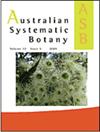Morphological analyses support recognition of three new threatened species of bracteate–prostrate Myosotis (Boraginaceae) endemic to the South Island of Aotearoa New Zealand
IF 1.6
3区 生物学
Q4 EVOLUTIONARY BIOLOGY
引用次数: 0
Abstract
ABSTRACT Statistical analyses of two morphological datasets, including 190 newly measured specimens, showed that individuals of Myosotis (Boraginaceae) from Te Waipounamu / South Island, Aotearoa, New Zealand, identified a priori with three different informal tag names, belong to the bracteate–prostrate group, are morphologically distinct from each other and from other species, and merit scientific description. Myosotis hikuwai Meudt, Prebble & G.M.Rogers is known from one location near Wānaka (Otago), has an unusual erect, spring annual habit, and is most similar to M. brevis and M. glauca, with which it is sympatric. Myosotis venticola Meudt & Prebble comprises plants that were sometimes previously identified as M. cheesemanii from certain ranges in Otago and southern Canterbury, but with retrorse trichomes present on the abaxial and adaxial side of the rosette leaves. Myosotis ultramafica Meudt, Prebble & Rance comprises individuals from ultramafic sites in certain ranges in Southland, and is most similar to M. cheesemanii and M. lyallii. We recommend that all three new species are listed as Threatened under the New Zealand Threat Classification System. In addition to descriptions and illustrations, the three new species are also included in a revised key to the nineteen species of southern hemisphere bracteate–prostrate Myosotis.形态学分析支持了新西兰奥特罗阿南岛特有的三种新的受威胁的苞片-匍匐肌索蒂斯(Boraginaceae)
摘要/ ABSTRACT摘要:对新西兰Aotearoa地区Te Waipounamu / South Island地区190个新测量标本的形态学数据进行了统计分析,结果表明,来自该地区的Myosotis (Boraginaceae)个体具有三个不同的非正式标签名,属于苞片-匍匐类,在形态上彼此不同,并且与其他物种不同,值得科学描述。Myosotis hikuwai Meudt, Prebble & G.M.Rogers在Wānaka(奥塔哥)附近的一个地方被人们所知,它有一个不寻常的直立,每年春天的习性,与m.b ulvis和m.g lauca最相似,与它们是共生的。Myosotis venticola Meudt & Prebble包括以前在奥塔哥和坎特伯雷南部某些地区被鉴定为M. cheesemanii的植物,但在玫瑰结叶的背面和正面有反向的毛状体。超amafica Meudt, Prebble & Rance由来自南部地区某些范围的超amafic遗址的个体组成,与M. cheesemanii和M. lyallii最相似。我们建议在新西兰威胁分类系统下将这三个新物种列为受威胁物种。除了描述和插图外,这三个新物种还被列入南半球苞片-匍匐肌索虫十九种的修订目录中。
本文章由计算机程序翻译,如有差异,请以英文原文为准。
求助全文
约1分钟内获得全文
求助全文
来源期刊

Australian Systematic Botany
生物-进化生物学
CiteScore
3.10
自引率
12.50%
发文量
12
审稿时长
>12 weeks
期刊介绍:
Australian Systematic Botany is an international journal devoted to the systematics, taxonomy, and related aspects of biogeography and evolution of all algae, fungi and plants, including fossils. Descriptive taxonomic papers should normally constitute a comprehensive treatment of a group. Short papers on individual species and nomenclatural papers must contain significant new information of broader interest to be considered. The prestigious L.A.S. Johnson Review Series is published. Other review articles will also be considered. All papers are peer reviewed.
Australian Systematic Botany is published with the endorsement of the Commonwealth Scientific and Industrial Research Organisation (CSIRO) and the Australian Academy of Science.
 求助内容:
求助内容: 应助结果提醒方式:
应助结果提醒方式:


